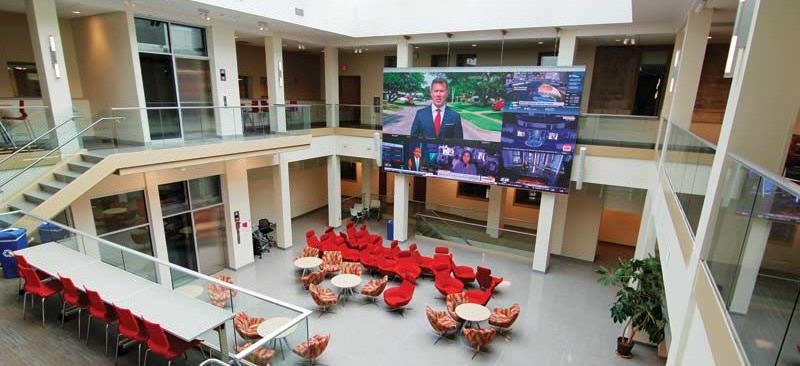By Stephen Montgomery
Digital signage can be found almost everywhere today. According to research by ElectroniCast Consultants, the value of the worldwide digital signage display market—including all associated hardware, software and application-specific services—reached US$17.6 billion in 2016. Given the scale of the industry, it is no wonder there is a wide variety of communication links between the hardware and software it uses.
Hardware components include not only the display devices themselves, but also the compact personal computers (PCs) that serve as media players and system-on-a-chip (SoC) interfaces. Software includes the hardware’s operating system (OS) and the content management system (CMS) that governs what appears on a display (see page 38), allowing it to be changed frequently. Immediate communications between transmitters and receivers can be achieved wirelessly for short links, with copper wire for medium links or fibre optic cable for links anywhere up to 20 km (12.4 mi).
The choice of components will depend on the location of the digital signage deployment. Outdoor installations may be on- or off-premise, while indoor applications range from office buildings and educational institutions to hotels, bars, restaurants, shops and malls to airports, train stations and bus terminals.
Displays
The most common types of display technology for digital signage are liquid crystal displays (LCDs) and light-emitting diode (LED) screens, but other options include interactive touch screens, digital projectors, transparent or ‘mirror’ organic LED (OLED) displays and even quantum dot (QD) displays. All can be used to clearly convey digital images, video, streaming media and information, but some support more innovative ways of doing so.
In May 2016, for example, the first commercial installation of a Samsung integrated digital signage mirror display was undertaken at a beauty salon in Seoul, South Korea. As shoppers approach the display—which is a mirror, but with a transparent OLED display mounted onto it—its embedded proximity sensor activates a transition from traditional promotional content to a mirror image. This way, a single panel within the salon can provide both the visual clarity of a standard mirror and the informative customer experience of digital signage.
The display’s components include an SoC semiconductor and a multiple-core central processing unit (CPU) with 8 GB of storage to support Samsung’s MagicInfo CMS, which brings up advertising messages based on customers’ proximity and dwell time. In a clothing store, for example, a man looking in the mirror while trying on suits might also see promotional content for shirts, ties, shoes and other related items.
One of the advantages of the solid-state nature of media players and other hardware components, including screen enclosures, is their resistance to damage.
“Shatter-proof modules are particularly useful with regard to digital signage vandalism incidents,” says Nathan Remmes, vice-president (VP) of corporate development for LED display manufacturer NanoLumens. “While such incidents are rare, they can represent a major concern for network operators.”

Indoor digital signage environments include train stations (left), casinos (middle) and educational institutions (right).






